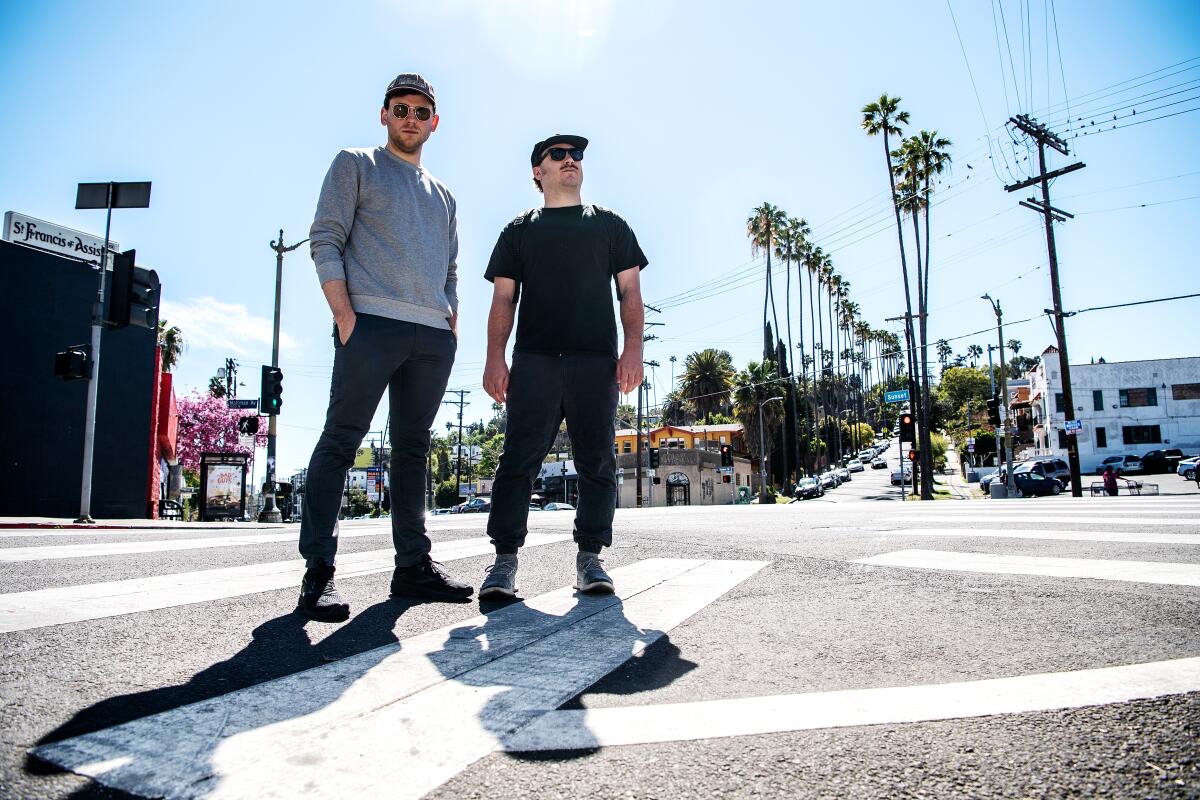‘Barbara Walters wasn’t a brand?’: Taylor Lorenz discusses journalism branding controversy

Good morning, and welcome to the Essential California newsletter. It’s Monday, March 7. I’m Justin Ray.
Last week, a reporter was at the center of a fierce debate about journalism on Twitter. But the heated discussion is one that many industries are having: Should you simply focus on working hard at your job and serving your employer, or does the hyper-competitive global economy force you to focus on promoting yourself and your career?
To quickly summarize what went down: On March 2, Business Insider published a story about top New York Times reporters “eyeing jobs elsewhere where they get more money and autonomy.” It specifically highlighted “influencer journalists” who desire to expand their reach through projects separate from the newsroom. Social media users widely commented on a quote from Los Angeles-based tech reporter Taylor Lorenz, who recently left the New York Times for the Washington Post.
“When you think about the future of media, it’s much more distributed and about personalities,” Lorenz is quoted in Business Insider. “Younger people recognize the power of having their own brand and audience, and the longer you stay at a job that restricts you from outside opportunities, the less relevant your brand becomes.”
According to command-F, the word “brand” only appears twice in the entirety of the piece (both instances occurring in the Lorenz quote). But that was enough to spark a Twitter conversation that lasted days.
“I think sometimes I forget how a lot of people are still marinating in this old system that’s kind of dying,” Lorenz told The Times. “It’s so funny to me when those people are like ‘journalists aren’t brands.’ It’s like, what the hell are you talking about? Barbara Walters wasn’t a brand?”
When it comes to branding and the influencer economy, Lorenz — who moved from New York to Los Angeles in 2020 — says that West Coast journalists understand the business a lot more than their East Coast counterparts. That’s because the disruption is happening in front of their eyes.
For some, the controversy is a proxy war for the battle between one generation that values company loyalty and earnest work, and another that values their own careers. Others argue that leaving branding to companies results in gender and racial discrimination. While there were valid points on both sides, the discussion eventually devolved into a public food fight among the people responsible for keeping the public informed.
An industry, disrupted

Lorenz has amassed more than 500,000 TikTok followers. She has over 259,000 followers on Twitter (a mere 256,000 more than me). Her job change was covered by Vanity Fair. She produces content on her own channels and has built a niche for herself, covering social media trends and influencer culture. In many ways, she is living the quote that caused the debate: She is her own entity.
“You see companies like where I used to work seize more and more control from their journalists. There’s this weird tension where legacy media brands want everybody to work in service of their brand,” Lorenz said. (Rebecca Blumenstein, deputy managing editor at The New York Times, claims in the Business Insider story that a new committee that decides whether or not reporters can do work outside of the paper has approved more than 90% of pitched projects.)
Nevertheless, it is worth pointing out that Lorenz is leaving one legacy newsroom for another. She says that she went to the Post because the paper gave her more freedom to do projects internally and externally. She also said she works for legacy media because she’s interested in “helping these organizations think in a more forward-thinking way and a more inclusive way.”
Speaking of inclusion, it is important to highlight the issue of who gets opportunities in media. This paper had its own reckoning about the different outcomes of reporters. Lorenz argues that because people can build their own followings, media industries are forced to recognize different talent.
“Legacy newsrooms have only built a specific type of person as a brand. It’s this cisgender, white, privileged kind of outlook,” she said. “They’re all pretty homogenous. And if you look at this rise of the internet and talent bubbling up from the internet, it’s a much more diverse group of people. For media companies to compete with that, they need to diversify who they view as talent.”
I’ve thought a lot about her argument and I think it has a lot of merit, especially because I have heard about too many people who got laid off by media companies and had nothing to show for their work. But I cannot ignore the fact that it was the Los Angeles Times that gave me a large platform. I don’t have a lot of followers. I’m not well-known. I have worked hard and those efforts have been rewarded. But I recognize I definitely don’t represent everyone, and it’s also possible that getting good at your job and looking out for your own career aren’t mutually exclusive.
Discussing changes in the industry can be beneficial, but one reason why the debate became heated has to do with the medium that journalists love so much; despite its many benefits, Twitter is not the best place to have a nuanced discussion. The character limit and lack of an edit button prevent extended conversations and thought development. Twitter’s algorithms reward hyperbole and aggressive language. Points made are judged by likes and retweets, not by the strength of their arguments.
“I’m so surprised that this is controversial because it’s just kind of a tale as old as time,” Lorenz says.
And now, here’s what’s happening across California:
Note: Some of the sites we link to may limit the number of stories you can access without subscribing.
This treatment can protect vulnerable people from COVID. But many don’t know about it. A preventive treatment is becoming urgent for people who do not generate enough antibodies to gain protection from the COVID-19 vaccines. Los Angeles Times

L.A. STORIES
From a fireworks tip to ‘catastrophic failure’ in 12 hours: How the LAPD blew up a neighborhood. A new inspector general’s report reveals new details about a June blast that damaged 35 properties and displaced dozens of residents. Los Angeles Times

They walked 50 miles in a day, and swear L.A. is ‘very walkable.’ In a city notorious for its freeways and headache-inducing traffic, most Angelenos know the saying “Nobody walks in L.A.” is far from the truth. But few have attempted to walk 50 miles across its sun-soaked expanses over the course of a single day. That’s how two 30-year-olds spent part of their Presidents Day weekend — walking from Pasadena City College to south of the Redondo Beach Pier in roughly 18 hours. Los Angeles Times

Our daily news podcast
If you’re a fan of this newsletter, you’ll love our daily podcast “The Times,” hosted every weekday by columnist Gustavo Arellano, along with reporters from across our newsroom. Go beyond the headlines. Download and listen on our App, subscribe on Apple Podcasts and follow on Spotify.
POLITICS AND GOVERNMENT
The salary for Stockton’s city manager is greater than the salary of California’s governor. You read that right. Stockton City Council members voted 5 to 2 to make changes to the employment contract between the city of Stockton and City Manager Harry Black. Those changes included adding on 30 vacation days and changing Black’s base salary from $270,000 to $294,953. Black’s salary is now $76,397 more than the salary for California Gov. Gavin Newsom, whose salary is reportedly $218,556. ABC10
UC Berkeley will boost the number of Californians and significantly reduce out-of-state and international students this fall as it scrambles to meet a court-ordered enrollment cap for the coming academic year just a few weeks before admission decisions are set for release. Overall, the campus plans to enroll about 5,370 first-year California students both in-person and online this fall, an increase of about 500 over last year. They would make up about 90% of all freshmen, compared with 70% last year. Los Angeles Times
CRIME, COURTS AND POLICING
A Sacramento County sheriff’s captain who served as Rancho Cordova’s police chief retired last year amid an investigation into her alleged sharing of a racist meme and use of homophobic slurs. Kate Adams was “placed on an extended administrative leave” before her retirement in September. The leave came after she allegedly sent others an image showing a white man, wearing sunglasses and holding a beer, spraying a Black child in the back of the head with a garden hose. The caption reads: “Go be a n----- somewhere else.” Sheriff’s Office spokesman Sgt. Rodney Grassmann said the matter was investigated externally and “since it was not our investigation, we cannot comment further.” Sacramento Bee
Support our journalism
HEALTH AND THE ENVIRONMENT
California would allow nurse practitioners to more easily work independently of a doctor and perform abortions under legislation that expands reproductive care as other states move to restrict access. The bill is one of several introduced this year by California Democrats who have been preparing countermeasures to expand abortion access for those who live in and out of the state. Los Angeles Times
As guidelines loosen, workers in certain industries are vulnerable. With state and federal officials loosening guidelines and requirements in the last week, workers in industries that require interaction with the public (e.g. grocery store employees, fast-food workers, etc.) won’t be required to wear masks indoors anymore. This is particularly concerning because many of these workers are people of color who are about twice as likely to die from COVID-19 as white people, according to a Kaiser Family Foundation analysis. “With the new state rules making masks voluntary, employees are effectively on their own if their employer decides to ditch masking as a protective measure,” Minerva Canto writes. Capital and Main
CALIFORNIA CULTURE
California bill would ban racist term in location names. Growing up on the San Manuel Indian Reservation in San Bernardino County, Assemblymember James C. Ramos said “squaw” was one of many disparaging terms hurled at his Native American community. Now Ramos is one of several lawmakers proposing to strip the word — a slur aimed at Indigenous women — from the name of more than 100 places across the state. “There should be no reason why there shouldn’t be support to change the S-word, that is so degrading to Native American women, in the year 2022,” said Ramos, the first — and currently only — Indigenous member of the state Legislature. Los Angeles Times
Pickleball noise is fueling neighborhood drama. A nearly 60-year-old sport has seen a surge in interest during the pandemic, wreaking genteel havoc from coast to coast. Los Angeles Times
A new company based in West Sacramento is entering the fake meat industry. The Better Meat Co. has expanded from CEO Paul Shapiro’s Sacramento kitchen table in 2018 to a 12,500-square foot West Sacramento facility with 15 employees. The company plans to fill a full-scale industrial plant within the next 18 months. Its product is derived from mycelium, the fungal microorganism that makes up mushrooms. The company calls the finished product “Rhiza,” Latin for “root.” Reporter Benjy Egel writes: “It’s beige and bland, looking somewhat like shredded chicken or tuna.” But Better Meat says the businesses it sells to (like Hormel) can then make their own proprietary products from Rhiza, turning it “into just about any kind of imitation meat with close taste and texture.” Sacramento Bee
Free online games
Get our free daily crossword puzzle, sudoku, word search and arcade games in our new game center at latimes.com/games.
CALIFORNIA ALMANAC
Los Angeles: Sunny 69 San Diego: Sunny 64 San Francisco: Sunny 63 San Jose: Sunny 68 Fresno: Sunny 65 Sacramento: Sunny 70
AND FINALLY
Today’s California memory is from Heather Howard:
Growing up in Dana Point in the mid-’70s was an idyllic childhood. This was a time before the digital world and helicopter parental supervision. A time before overdevelopment. When there were still empty fields of tall grass, perfect for running and hiding, and the bare bluffs stood verdant as we climbed down their sandy cliffs to the deserted beaches below. I remember skateboarding down our steep and winding street and walking to school, dragging giant tumbleweeds behind us as we trudged up the rolling hills of the Dana Dips. This was a time when play required curiosity, creativity, and imagination.
If you have a memory or story about the Golden State, share it with us. (Please keep your story to 100 words.)
Please let us know what we can do to make this newsletter more useful to you. Send comments to [email protected].
Sign up for Essential California
The most important California stories and recommendations in your inbox every morning.
You may occasionally receive promotional content from the Los Angeles Times.




